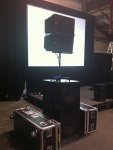Re: Intermod distortion 2-way vs 3-way
Thanks for all the info so far - I'm learning a lot. Thanks Peter for the Neumann article. Intuitively it makes sense - the more cone motion you have, the more potential for intermod. Use larger drivers and less excursion is required for the same air movement.
How does this play out in ultra-long excursion boxes like Vertec 4886 where a pair of 6.5" drivers are working down to 70Hz?
TJ,
Intermodulation distortion does not become objectionable until the speaker is driven beyond Xmax, cone travel length in itself is not the problem.
A small speaker can still sound clean up to Xmax, but what is often overlooked is a ported cabinet has it's excursion minima at Fb, which is about as low (or below) where the low crossover point would usually be set, while the excursion maximum occurs about 1/3 octave above Fb.
Unfortunately, most manufacturers are more concerned with the speaker not burning up than sounding good at high power, which has led to many designs where the speaker can be driven way beyond Xmax at well below rated power.
Although rated SPL may be accurate for such a speaker, it may sound like total gack at 6-10 dB less level than rated for.
The "gargling" IM sound occurs in vocal reproduction when low frequency tones cause the cone to exceed Xmax. As the loudspeaker excursion exceeds Xmax, the amount of voice coil that is within the magnetic gap decreases. As the cone movement takes the voice coil outside the gap, the amount of force produced by the voice coil, for a given input, decreases, and distortion increases radically.
To visualize what occurs in IM, think of a speaker playing 100 Hz and 1000 Hz tones.
For each in and out motion the 100 Hz tone causes, the cone is also making 10 smaller in and out motions from the 1K tone.
When the 100 Hz signal is strong enough to push the coil outside the gap (exceeds Xmax) the 1000 Hz signal no longer is reproduced properly at the end of the inner and outer stroke.
The amplitude (SPL) of the 1000 Hz tone is actually reduced at either end of the 100 Hz stroke, the period (length) of the 1000 Hz distortion is modulated by the 100 Hz signal.
A lower low note makes for an longer modulation period, and our ears will notice more “gargling” if the modulation tone was 60 or 70 Hz than 100.
Doubling Xmax requires twice the magnetic gap, but allows for 6 dB more output without “gargling”.
It also costs a lot of money to do, often considerably more than two speakers with half the Xmax that would put out equal SPL using half the power.
There is no replacement for displacement, whether in cars or speaker cabinets we will always pay a premium for large displacement in a small package.
For some, like Dave Rat, not having to carry separate PA for vocals and instruments to avoid IM made it worth the added expense of a single PA that had the required displacement.
For others, not pushing the PA the last 6 dB it was capable of before burning up might be an adequate solution...
Art


